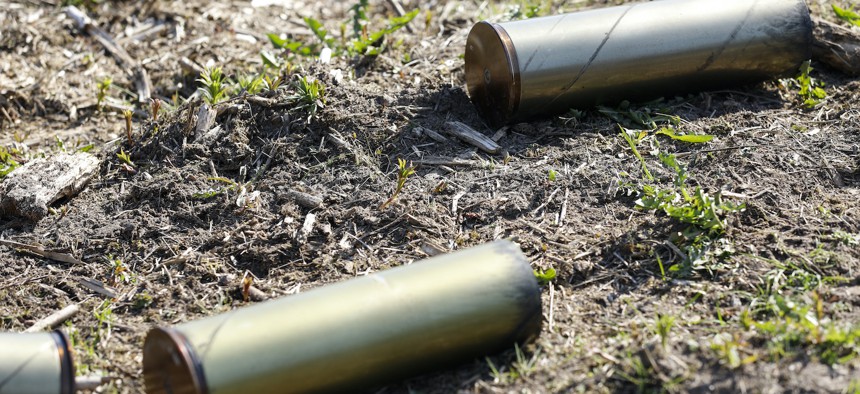
Empty 105 mm shells from the M119 howitzer during a live fire exercise in Estonia, May 10, 2021. U.S. Army / Staff Sgt. Michael Gresso
Army eyes munitions stockpiles amid focus on longer wars
The Army is using robots to help ratchet up shell production, but precision missiles are a harder problem.
From precision missiles to artillery shells that would be familiar to any World War II artilleryman, assistant Army secretary for acquisition Doug Bush handles it all.
Chief among his duties: making sure the U.S. actually has enough to fire, particularly amid heavy usage of U.S. munitions in Ukraine and high projected demands for war with China.
But while the Army is blazing ahead with more production of the Army’s 155mm standard artillery shells thanks to cash injections and modernization, rapidly producing more advanced missiles is a more challenging task, Bush said during an interview at the annual conference of the Association of the U.S. Army.
The Army has increased production of 155mm shells, both to feed Ukraine’s perennial shell hunger and restock U.S. armories. The U.S. currently produces around 28,000 155mm shells a month, as it hustles to feed Ukrainian cannons that fire upwards of 240,000 shells per month.
Following plans announced in April, the Army anticipates increasing production to 60,000 per month in fiscal year 2024, to 80,000 per month in 2025, and to 100,000 a month in early fiscal year 2026, Bush previously told Defense News.
To do so, the service is investing heavily in a network of government-owned munitions plants. Last week, the Army announced a $1.5 billion dollar investment in shells, part of which was aimed at increasing production capacity.
The plan includes modernization, Bush told Defense One. For example, a Texas plant run by General Dynamics will add additional robots and make the operating environment safer, Bush said.
“It’s 21st Century manufacturing,” he said. The plant will “have a whole new technology for making shells.”
Other plants also will eventually be updated and modernized, such as a munitions plant in Scranton, Pennsylvania, Bush said. A new munitions load-and-pack facility in Iowa will likewise see large investments in modernization, including significant automation. “It's going to be dramatically better and safer for the workforce,” Bush said.
The modernization efforts include a gradual switch over to the new, longer-range M1128 shell from the 1980s-era M795 round, Bush said.
As it prepares for the future, the U.S. has had to solve some logistical problems, chief of which has been getting the right machine tools. “The big machine tools that make the shells, the equipment that loads the shells with explosives, that's been the long pole in the tent,” said Bush.
However, the government can solve these problems with relative ease because it controls the manufacturing process for things like artillery shells and artillery components, such as howitzer barrels.
What it can’t directly control is the production of advanced munitions, because they are made “almost entirely” in the private sector, Bush said.
Industry giant Lockheed Martin manufactures both the Guided Multiple Launch Rocket System (GMLRS), which has seen heavy use in Ukraine, and the new Precision Strike Missile (PrSM), which is part of U.S. plans for fighting in the Pacific and Europe.
Lockheed has already increased production of certain weapons, like the GMLRS, to the maximum rate because of the war in Ukraine.
Further increases would require major investments, like expanding facilities and hiring skilled laborers. But the Army has historically bought such weapons year by year, giving companies little incentive to make these investments. In some cases, companies may not even retain the skill sets necessary to build their products—following a surge in demand because of Ukraine, Raytheon had to lure 70-year olds out of retirement to teach new workers how to build Stinger anti-aircraft missiles.
Recently, the Army has pushed for multi-year buys of certain weapons, like GMLRS, to give companies an incentive to invest.
Sales to foreign countries are also an efficient way to keep companies investing in manufacturing and retaining skilled workers, Bush said. GMLRS is “going to be in terrific shape for a long time,” Bush said. Other solutions for providing surge capacity may be to subsidize industry’s investments in production capabilities in some way, Bush added.
The Office of the Secretary of Defense is also discussing what the U.S. might need to do to organize industry for a long-scale war.
“What we need is more industrial planning” for a long conflict, Bush said.
Given the complexity of many advanced munitions, drawing from established stockpiles may be a better solution than creating the ability to quickly ramp up production at a moment's notice, according to Bush: “It’s not going to be cheap, but if we're going to be planning for longer conflicts, we just need bigger stockpiles.”
Before these decisions are made, the Army needs to have enough acquisition personnel to even execute its policies.
With a government shutdown narrowly averted last month and a potential shutdown looming, such workers may be lured away by a private sector that also needs their skills, he said.
“If I worry about one thing, it’s that workforce and maintaining it, because we can do nothing without it.”


